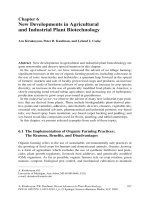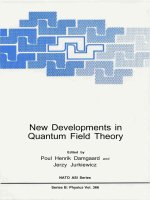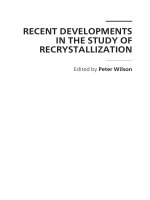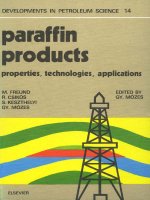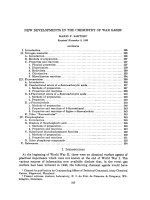- Trang chủ >>
- Khoa Học Tự Nhiên >>
- Vật lý
Developments in 3d geoinformation sciences
Bạn đang xem bản rút gọn của tài liệu. Xem và tải ngay bản đầy đủ của tài liệu tại đây (10.32 MB, 234 trang )
Lecture Notes in Geoinformation and Cartography
Series Editors: William Cartwright, Georg Gartner, Liqiu Meng,
Michael P. Peterson
Tijs Neutens · Philippe De Maeyer
Editors
Developments in 3D
Geo-Information Sciences
123
Editors
Tijs Neutens
University of Ghent
Dept. Geography
Krijgslaan 281
9000 Gent
Belgium
Dr. Philippe De Maeyer
University of Ghent
Dept. Geography
Krijgslaan 281
9000 Gent
Belgium
ISSN 1863-2246
e-ISSN 1863-2351
ISBN 978-3-642-04790-9
e-ISBN 978-3-642-04791-6
DOI 10.1007/978-3-642-04791-6
Springer Heidelberg Dordrecht London New York
Library of Congress Control Number: 2009937575
c Springer-Verlag Berlin Heidelberg 2010
This work is subject to copyright. All rights are reserved, whether the whole or part of the material is
concerned, specifically the rights of translation, reprinting, reuse of illustrations, recitation, broadcasting,
reproduction on microfilm or in any other way, and storage in data banks. Duplication of this publication
or parts thereof is permitted only under the provisions of the German Copyright Law of September 9,
1965, in its current version, and permission for use must always be obtained from Springer. Violations are
liable to prosecution under the German Copyright Law.
The use of general descriptive names, registered names, trademarks, etc. in this publication does not imply,
even in the absence of a specific statement, that such names are exempt from the relevant protective laws
and regulations and therefore free for general use.
Printed on acid-free paper
Springer is part of Springer Science+Business Media (www.springer.com)
Preface
Realistically representing our three-dimensional world has been the subject of
many (philosophical) discussions since ancient times. While the recognition of
the globular shape of the Earth goes back to Pythagoras’ statements of the
sixth century B.C., the two-dimensional, circular depiction of the Earth’s
surface has remained prevailing and also dominated the art of painting until
the late Middle Ages. Given the immature technological means, objects on the
Earth’s surface were often represented in academic and technical disciplines
by two-dimensional cross-sections oriented along combinations of three
mutually perpendicular directions. As soon as computer science evolved,
scientists have steadily been improving the three-dimensional representation of
the Earth and developed techniques to analyze the many natural processes and
phenomena taking part on its surface. Both computer aided design (CAD) and
geographical information systems (GIS) have been developed in parallel
during the last three decades. While the former concentrates more on the
detailed design of geometric models of object shapes, the latter emphasizes the
topological relationships between geographical objects and analysis of spatial
patterns. Nonetheless, this distinction has become increasingly blurred and
both approaches have been integrated into commercial software packages.
In recent years, an active line of inquiry has emerged along the junctures
of CAD and GIS, viz. 3D geoinformation science. Studies along this line have
recently made significant inroads in terms of 3D modeling and data
acquisition. Complex geometries and associated topological models have been
devised to approximate three-dimensional reality including voxels,
polyhedrons, constructive solid geometry (CSG), boundary representation (Brep) and tetrahedral networks. As input for these models, new technologies to
collect three-dimensional data have become fully operational such as mobile
mapping and 3D laserscanning. However, in light of these advances, up until
now there is still a pressing need for robust 3D analysis and simulation tools
that can be applied effectively in a wide range of fields such as urban
planning, archaeology, landscape architecture, cartography, risk management
etc.
vi
In response to the lingering demand for 3D analysis and simulation tools,
a workshop on 3D geoinformation was held in Ghent, Belgium on November
4-5, 2009. Following the successful series of past workshops, the Fourth
International Workshop on 3D Geoinformation offers an international forum
to promote high-quality research, discuss the latest developments and
stimulate the dialogue between academics and practitioners with respect to 3D
geoinformation, acquisition, modeling, analysis, management, visualization
and technology.
This book contains a selection of full-papers that were presented at the
workshop. The selection was based on extensive peer-review by members of
the Program Committee. Only the most significant and timely contributions
are included in this book. Selected contributors were asked to submit a revised
version of their paper based on the reviewers’ comments. All other papers and
extended abstracts that were selected for oral or poster presentation at the
workshop are published in a separate proceedings book.
The editors of this book would like to thank the many people who helped
making this year’s 3D GeoInfo workshop a success. We owe special thanks to
Marijke De Ryck, Dominique Godfroid and Helga Vermeulen for their great
help in organizing the conference, and Bart De Wit and Lander Bral for their
excellent technological support. Thanks also go to Sisi Zlatanova for sharing
experiences and advice on various aspects regarding the workshop, Agata
Oelschlaeger for guiding us through the publication process and our sponsors
for financial support. Finally, we would like to thank the members of the
Program Committee for carefully reviewing the full papers and all those who
submitted their work and participated in 3D GeoInfo 2009.
Ghent, Belgium
August 2009
Tijs Neutens
Philippe De Maeyer
Program Co-chairs
Programme co-chair Philippe De Maeyer
Ghent University (Belgium)
Programme co-chair Tijs Neutens
Ghent University (Belgium)
Local Committee
Marijke De Ryck, Dominique Godfroid, Helga Vermeulen
Ghent University (Belgium)
Program Committee
Alias Abdul-Rahman, University of Technology Malaysia (Malaysia)
Roland Billen, University of Liege (Belgium)
Lars Bodum, Aalborg University (Denmark)
Peter Bogaert, Geo-Invent (Belgium)
Arnold Bregt, Wageningen University and Research Centre (The Netherlands)
Volker Coors, University of Applied Sciences Stuttgart (Germany)
Klaas Jan De Kraker, TNO (The Netherlands)
Alain De Wulf, Ghent University (Belgium)
Claire Ellul, University college London (United Kingdom)
Robert Fencik, Slovak University of Technology (Slovakia)
Andrew Frank, TU Wien (Austria)
Georg Gartner, TU Wien (Austria)
Christopher Gold, University of Glamorgan (United Kingdom)
Muki Haklay, University College London (United Kingdom)
Thomas Kolbe, Technical University Berlin (Germany)
Jan-Menno Kraak, ITC (The Netherlands)
Mei-Po Kwan, Ohio State University (USA)
Hugo Ledoux, Delft University of Technology (The Netherlands)
Jiyeong Lee, University of Seoul, (South Korea)
Ki-Joune Li, Pusan National University (South Korea)
Twan Maintz, Utrecht University (The Netherlands)
viii
Mario Matthys, University College Science and Art (Belgium)
Martien Molenaar, ITC Enschede (The Netherlands)
Stephan Nebiker, Fachhochschule Nordwestschweiz (Switzerland)
András Osskó, FIG/Budapest Land Office (Hungary)
Norbert Pfeifer, TU Wien (Austria)
Carl Reed, Open Geospatial Consortium (USA)
Massimo Rumor, University of Padova (Italy)
Mario Santana, K.U. Leuven (Belgium)
Aidan Slingsby, City University London (United Kingdom)
Uwe Stilla, Technical University of Munich (Germany)
Jantien Stoter, ITC Enschede (The Netherlands)
Rod Thompson, Queensland Government (Australia)
Marc Van Kreveld, Utrecht University (The Netherlands)
Peter Van Oosterom, Delft University of Technology (The Netherlands)
Nico Van de Weghe, Ghent University (Belgium)
George Vosselman, ITC Enschede (The Netherlands)
Peter Widmayer, ETH Zürich (Switzerland)
Peter Woodsford, 1Spatial and Snowflake Software (United Kingdom)
Alexander Zipf, University of Applied Sciences FH Mainz (Germany)
Sisi Zlatanova, Delft University of Technology (The Netherlands)
Contents
Euler Operators and Navigation of Multi-shell Building Models
Pawel Boguslawski and Christopher Gold ................................................ 1
True-3D Visualization of Glacier Retreat in the Dachstein Massif, Austria:
Cross-Media Hard- and Softcopy Displays
Katharina Bruhm, Manfred Buchroithner and Bernd Hetze ................... 17
Towards Advanced and Interactive Web Perspective View Services
Benjamin Hagedorn, Dieter Hildebrandt and Jürgen Döllner................ 33
Interactive modelling of buildings in Google Earth: A 3D tool for Urban
Planning
Umit Isikdag and Sisi Zlatanova ............................................................. 52
An Experimentation of Expert Systems Applied to 3D Geological Models
Construction
Eric Janssens-Coron, Jacynthe Pouliot, Bernard Moulin and
Alfonso Rivera ......................................................................................... 71
Data validation in a 3D cadastre
Sudarshan Karki, Rod Thompson and Kevin McDougall........................ 92
From Three-Dimensional Topological Relations to Contact Relations
Yohei Kurata ......................................................................................... 123
Needs and potential of 3D city information and sensor fusion
technologies for vehicle positioning in urban environments
Marc-Oliver Löwner, Andreas Sasse and Peter Hecker........................ 143
Modeling Visibility through Visual Landmarks in 3D Navigation using
Geo-DBMS
Ivin Amri Musliman, Behnam Alizadehashrafi, Tet-Khuan Chen
and Alias Abdul-Rahman....................................................................... 157
A 3D inclusion test on large dataset
Kristien Ooms, Philippe De Maeyer and Tijs Neutens .......................... 181
x
3D Volumetric Soft Geo-objects for Dynamic Urban Runoff Simulation
Izham Mohamad Yusoff, Muhamad Uznir Ujang and
Alias Abdul Rahman .............................................................................. 200
Contributing Authors
Behnam Alizadehashrafi
Dept. of Geoinformatics,
Faculty of Geoinformation
Science & Engineering,
Universiti Teknologi
Malaysia, 81310 Skudai,
Johor, Malaysia
Pawel Boguslawski
Department of Computing and
Mathematics, University of
Glamorgan, Wales, UK
Katharina Bruhm
Dresden University of
Technology, Germany
Manfred Buchroithner
Dresden University of
Technology, Germany
Tet-Khuan Chen
Dept. of Geoinformatics,
Faculty of Geoinformation
Science & Engineering,
Universiti Teknologi
Malaysia, 81310 Skudai,
Johor, Malaysia
Umit Isikdag
Eric Janssens-Coron
Geomatics Department,
Pavillon Louis-Jacques
Casault, Université Laval.
G1K 7P4, Quebec, QC,
Canada
Philippe De Maeyer
Department of Geography,
Krijgslaan 281 S8, 9000
Ghent, Belgium
Jürgen Döllner
Hasso-Plattner-Institute at the
University of Potsdam,
Germany
Christopher Gold
Department of Computing and
Mathematics, University of
Glamorgan, Wales, UK
Department of Geoinformatics, Universiti
Teknologi, Malaysia (UTM)
Benjamin Hagedorn
Hasso-Plattner-Institute at the
University of Potsdam,
Germany
xii
Peter Hecker
Institut
für
Flugführung,
Technische Universität
Braunschweig.
Bernd Hetze
Dresden University of
Technology, Germany
Dieter Hildebrandt
Hasso-Plattner-Institute at the
University of Potsdam,
Germany
Sudarshan Karki
Department of Environment
and Resource Management,
Queensland, Australia,
University of Southern Queensland, Australia
Yohei Kurata
SFB/TR8 Spatial Cognition,
Universität Bremen
Postfach 330 440, 28334 Bremen, Germany
Marc-Oliver Löwner
Institut für Geodäsie und Photogrammetrie, Technische Universität Braunschweig.
Kevin McDougall
University of Southern
Queensland, Australia
Bernard Moulin
Computer Sciences and
Software Engineering
Department. Pavillon AdrienPouliot, Université Laval.
G1K 7P4, Quebec, QC,
Canada
Ivin Amri Musliman
Dept. of Geoinformatics,
Faculty of Geoinformation
Science & Engineering,
Universiti Teknologi
Malaysia, 81310 Skudai,
Johor, Malaysia
Tijs Neutens
Department of Geography,
Krijgslaan 281 S8, 9000
Ghent, Belgium
Kristien Ooms
Department of Geography,
Krijgslaan 281 S8, 9000
Ghent, Belgium
Jacynthe Pouliot
Geomatics Department,
Pavillon Louis-Jacques
Casault, Université Laval.
G1K 7P4, Quebec, QC, Canada
Alias Abdul-Rahman
Dept. of Geoinformatics,
Faculty of Geoinformation
Science & Engineering,
Universiti Teknologi
Malaysia, 81310 Skudai,
Johor, Malaysia
xiii
Alfonso Rivera
Geological Survey of Canada.
490, rue de la Couronne. G1K
9A9, Quebec, QC, Canada
Andreas Sasse
Institut
für
Flugführung,
Technische Universität
Braunschweig.
Rod Thompson
Department of Environment
and Resource Management,
Queensland, Australia,
TU Delft, the Netherlands
Muhamad Uznir Ujang
Department of
Geoinformatics,
Faculty of Geoinformation
Science and Engineering,
University Technology
Malaysia,
81310 UTM Skudai,
Johor Bahru, Malaysi
Izham Mohamad Yusoff
Department of
Geoinformatics,
Faculty of Geoinformation
Science and Engineering,
University Technology
Malaysia,
81310 UTM Skudai,
Johor Bahru, Malaysi
Sisi Zlatanova
Euler Operators and Navigation of Multi-shell
Building Models
Pawel Boguslawski1 and Christopher Gold2
1
Department of Computing and Mathematics, University of Glamorgan,
Wales, UK
e-mail:
2
Department of Computing and Mathematics, University of Glamorgan,
Wales, UK Department of Geoinformatics, Universiti Teknologi, Malaysia
(UTM)
e-mail:
Abstract. This work presents the Dual Half Edge (DHE) structure and the associated
construction methods for 3D models. Three different concepts are developed and described with particular reference to the Euler operators. All of them allow for simultaneous maintenance of both the primal and dual graphs. They can be used to build cell
complexes in 2D or 3D. They are general, and different cell shapes such as building
interiors are possible. All cells are topologically connected and may be navigated directly with pointers. Our ideas may be used when maintenance of the dual structure is
desired, for example for path planning, and the efficiency of computation or dynamic
change of the structure is essential.
Keywords: 3D Data Models, 3D Data Structures, Building Interior Models,
Emergency Response, Disaster Management, Topology, CAD, Quad-Edge, 3D
Dual Graph, 3D Graph navigation, Euler Operators
1. Introduction
A cell complex may be considered to be made up of closed cells with geometric coordinates at the vertices. A graph connecting the “centres” of the cells is
the dual structure to a geometric model. Many researchers consider that only
T. Neutens, P. De Maeyer (eds.), Developments in 3D Geo-Information Sciences,
Lecture Notes in Geoinformation and Cartography, DOI 10.1007/978-3-642-04791-6_1,
© Springer-Verlag Berlin Heidelberg 2010
2
P. Boguslawski and C. Gold
the geometric graph need be stored, in 2D or 3D, as the dual can readily be reconstructed as required.
This traditional approach has various limitations. In many application disciplines attributes need to be assigned to entities (vertices, edges, faces, volumes) in either the primal or the dual space. (Here we consider the primal
space to be the one for which the basic geometric data was acquired.) In some
applications both primal and dual entities are needed simultaneously (e.g. watersheds, Maxwell equations). Sometimes the dual graph is critical for computationally-expensive analysis (e.g. network flow through the dual graph, calculation of kinetic Voronoi cell volumes) and it needs to be maintained
directly. Sometimes the spatial adjacency of cells needs to be referenced frequently (e.g. flow analysis).
These primal/dual issues may apply in other applications using arbitrary
geometry. In particular, CAD systems which permit the modelling of more
than one shell (non-manifold geometry) have similar requirements for the data
structure. Examples include the Radial-Edge, the Facet-Edge and the PartialEdge data structures, which require information about loops around vertices,
edges and faces. These may be visualized in terms of loops in primal and dual
space.
In 2D Guibas and Stolfi (1985) show the advantages of combining the primal and dual graphs in their Quad-Edge (QE) structure. The “Rot” pointer is a
combination of the “Sym” pointer of the Half-Edge (HE) structure, which
points to the matching Half-Edge, and a “Dual” pointer, which points to the
unique dual HE of the current HE. In 3D the Augmented Quad-Edge (AQE)
uses the QE for the shell around each vertex in either primal or dual space, but
replaces the QE Face pointer by the “Through” pointer, which is equivalent to
the “Dual”. The AQE allows direct pointer navigation to any entity in either
the primal or dual graph.
Model construction is difficult using the AQE because there is no convenient atomic element that can be used for incremental model construction, and
construction operators are difficult. It is only implemented for the 3D Voronoi/Delaunay model. In order to facilitate general 3D model construction
we developed the Dual Half-Edge (DHE) data structure, which preserves the
permanent link between the pair of primal/dual HEs, but allows the reconnection of pairs of HEs during construction. This approach approximately
halves the storage with respect to the AQE, and also allows the specification
of low-level construction operators that may be combined to produce “cardboard-and-tape” construction methods, 3D Euler operators, or even 2D QEs.
These higher level operators may be implemented directly by the modelbuilding software, as in CAD systems. Full navigation of the structure is preserved. Our objective is to use this model for disaster management: the planning of escape routes from complex buildings. Once a primal/dual model is
prepared, escape along the edges of the appropriate dual graph (including any
Euler Operators and Navigation of Multi-shell Building Models
3
relevant navigation attributes, such as speed) may be planned by standard
graph traversal methods, and modified in real time if necessary.
We believe that a (relatively) simple 3D primal/dual data structure will be
of benefit whenever more than just a geometric model is desired.
2. Related Work
3D data models can be classified into: Constructive Solid Geometry (CSG),
boundary-representations (b-rep), regular decomposition, irregular decomposition and non-manifold structures [1]. For our research b-reps and irregular
decomposition models are the most relevant. The well known b-reps are:
Half-Edge [2], DCEL [3], Winged-Edge [4] and Quad-Edge [5]. Irregular decomposition models (e.g. for constructing a 3D Delaunay tetrahedralization)
can be constructed with Half-Faces [6], G-maps [7] and Facet-Edges [8]. The
most important for us are the Quad-Edge (QE) and (its extension) the Augmented Quad-Edge (AQE) [1] data structures. These structures are suitable
for constructing models and their duals at the same time. We use dual space to
connect cells in cell complexes and to navigate between them. Navigation and
data structures are the same in both spaces. Both spaces are connected together and we do not need any additional pointers for this connection. Other
data structures like Half-Edge or Winged-Edge used widely in CAD systems
do not provide for management of the duality.
Quad-Edge The Quad-Edge (QE) was introduced by Guibas and Stolfi
[5]. Each QE consists of 3 pointers (Fig 1 a): R, N and V with 4 QEs connected together in a loop by the R pointer to create an edge (Fig. 1 b-c). They
are connected in an anticlockwise (CCW) direction. The next pointer N points
to the next edge with the same shared vertex or face (Fig. 1b). All edges connected by this pointer form a loop. This is a CCW connection as well. The
pointers R and N are directly used in Rot, Sym and Next simple navigation
operators. Rot uses R and returns the next quad from a loop of four. Sym calls
Rot twice. Next uses N and returns the next edge from the loop (Fig. 1 d). The
V pointer is used to point to coordinates of vertices in the structure.
4
P. Boguslawski and C. Gold
Fig. 1. Quad-Edge structure and navigation; a) single QE; b) four QEs connected using R pointer create an edge P0P1; c) simpler representation of the edge P0P1; d) relations between edges in a mesh – q (black) represents the original quad, grey quads are
an example of navigation.
To construct and modify graphs only two operations are needed – MakeEdge to create a new primal/dual edge pair, and Splice to connect/disconnect
it to/from the graph under construction. Tse and Gold showed that Euler Operators could easily be developed on the basis of QEs rather than half or
winged-edges [9].
The QE structure was originally used to describe both the primal and dual
graphs simultaneously. The particular example was triangulation modelling,
showing both the primal Delaunay triangulation and the dual Voronoi tessellation. Either graph may be navigated by simple pointer-following, using Rot
and Next pointers, with “Vertex” pointers to primal and dual graph nodes.
Based on the original Quad-Edge, five new developments have led to the
current full 3D volumetric Euler Operators:
Euler Operators and Navigation of Multi-shell Building Models
2.1.
5
Augmented Quad-Edge
In 3D, primal and dual graphs may also be defined: the dual of a face is an
edge, the dual of an edge is a face, the dual of a node is a volume and the dual
of a volume is a node. Ledoux and Gold defined an extension of the QuadEdge - the Augmented Quad-Edge (AQE) [1]. In this approach the “Vertex”
pointer to a face (usually unused) was assigned to the dual edge of that face.
This was called “Through” and allowed navigation between cells via the dual
edge.
Fig. 2. The AQE structure is suitable for modelling 3D. The set of operators allow for
navigation inside one cell as well as between cells.
As seen in Fig. 2, “Through” points to the associated dual edge. Selecting
“Sym” then “Through” again returns navigation to the matching edge in the
primal space. “Adjacent” is a compound operator returning the matching quad
in the adjacent cell. Thus q.Adjacent=q.Through.Next.Through.Sym. The result is the adjacent face from the next cell. The original QE operators are restricted to a single cell; the AQE model allows navigation between cells.
The target application for the AQE was the 3D Voronoi/Delaunay structure.
The difficulty with this model was that the construction operators were complex, in particular the “Through” pointer maintenance during VD/DT construction.
2.2.
Dual Half-Edge (DHE)
The previous Augmented Quad-Edge was a direct modification of Guibas and
Stolfi’s [5] Quad-Edge structure. Starting from the AQE, we derived our new
Dual Half-Edge structure (Fig. 3) by permitting individual Half-Edges to exist, in order to facilitate construction operations, and enforcing a permanent
6
P. Boguslawski and C. Gold
link between the matching primal and dual Half-Edges, and simplifying the
resulting pointer structure. This significantly reduces the space requirements
while retaining full navigation of all points, edges, faces and volumes.
Fig. 3. Dual Half Edge a) singular DHE; the black primal half aP corresponds to Pa
vertex and is permanently connected to the grey dual half aD that corresponds to the
Paa vertex; b) two paired DHEs form an edge; c) the edge represented with QE..
2.3.
Atomic elements
In order to create fully navigable structures from the DHE the open “Sym”
pointers must be paired to give the required atomic element. A primal or dual
edge is formed with one or two distinct vertices. Thus the “Next” pointer has
to point to itself or to the second end of the edge. It gives us four possible
combinations, as shown in Fig. 4. We use them as a base element for three
different construction methods: Quad-Edge (QE), Cardboard&Tape (C&T)
and Euler Operators (EO).
The atomic element P0P1D0, for example, is the well-known “Make-Edge”
element used in the QE structure [5]: two distinct vertices exist in the primal
space, but the dual edge connects to itself. Element P0D0D1 is the same, except
that the two distinct vertices are in the dual space. These are the simplest elements in construction of 2D meshes like triangulation and 3D singular cells.
The dual is constructed simultaneously and represents relationships between
2D cells on the 2-manifold. This is equivalent to structures used in simple
CAD systems, but cannot be used for a non manifold model.
Euler Operators and Navigation of Multi-shell Building Models
7
Fig. 4. Four possible combinations of two DHEs. The curved lines are represented in
3D space and form a double-sided face. The face is penetrated by the dual edge.
2.4.
Cardboard & Tape models
In [10] we described a spatial model based on directly opposed faces, with no
spatial entity between. We called this the “Cardboard and Tape” (C&T)
model, as this is intuitively how it is used. To construct a “wall” (the “Cardboard”) we start from one vertex and “loop edge” (P0D0) and then add new
vertices – we split an existing edge. This is illustrated in Fig. 5.
8
P. Boguslawski and C. Gold
Fig. 5. Construction of a face. New edges are created by adding a new vertex and
splitting an existing edge.
These “walls” (or “floors”, etc.) are then joined together as desired to give
our final building structure, using our “Sew” operator. This simple operator
changes only “Sym” pointers in one space. One edge at a time of the doubleface is un-snapped, the same is done for the receiving face, and then the halffaces are snapped back together in the new configuration (Fig. 6). This directly mimics the construction of a cardboard model using sticky tape! All operations are defined to be reversible. While not shown in Fig. 6 the dual graph
is constructed automatically as the primal graph is built. This approach may
be used to construct a cell complex. Visualization of a model is very easy: to
get all points, edges or faces of a cell we use a breadth–first traversal of the
graph, as we would with a single shell formed by QEs. All cells are connected
by the dual structure, which is also a graph.
Euler Operators and Navigation of Multi-shell Building Models
9
Fig. 6. Sew operator snaps two faces: a) two separate faces; b) unsnapped edges; c)
edges snapped into new configuration.
2.5.
Euler Operators
The simplest element it is possible to construct in the C&T model is a face. It
was not possible to create a single edge with two different vertices (segment
line). The primal (geometry) does not cause a problem, but in the dual two
not-paired halves of edges do not allow for navigation in the model. The solution to this problem is to keep the external shell together with the internal,
original one. This allows us to connect spare pairs of half-edges. It means
every edge created using this new method has its counterpart in the external,
adjacent shell.
This new idea of keeping the external shell and the last two elements not
described yet (P0P1D0D1 and P0D0 from Fig. 4) may be used to define an Euler
Operator spatial model for full 3D with “Volume” nodes in the dual graph.
For complete cell complexes the results are the same as with the C&T model,
but it also allows incomplete items, such as edges – which may be needed
during the construction process or preserved as final elements. This provides a
new data structure for use in CAD system design [11] as an alternative form
of non-manifold structure, similar to the radial-edge [12] and facet-edge [8]
models.
The main difference between C&T and EO is a possibility of edges construction. Only the EO method allows for that. New edges can be added to the
model at any time. In C&T we can add only final faces and connect them with
the existing model. Another difference can be found in incomplete models.
Two shells (internal and external) are present all the time when the EO
method is used. Even a single edge has its external counterpart. It does not
make any difference if the created cell is complete or not. In the C&T method
the external cell is separated when the cell is closed - for example when the
last face of a tetrahedron, cube or any polyhedron is added. The result of these
two methods is the same (number of edges, connections between entities, etc.)
10
P. Boguslawski and C. Gold
only if we construct closed polyhedra. Other (incomplete) models are different.
3. Euler Operators in construction of building models
The set of Euler Operators we developed is sufficient to implement the construction or modification of a solid object. This covers the “spanning set” [13]
and is a part of a bigger set of all possible Euler Operators. It may be expanded, and cell complex construction is also possible in the way described
by Lee [11].
Construction of a single shell without the dual is a simple process using
traditional Euler Operators: the dual may not be important when not working
with cell complexes. It should be emphasized here that in our model the dual
graph connects individual cells of the primal.
Managing the dual space simultaneously with modification of the primal
requires more complex operators – although once defined they may be used as
simply as the traditional ones. In return we get automatic and local changes in
the dual when the geometry of the primal is changed. No additional operations
are needed. The dual is present all the time and navigation in the model is
valid at every step of the construction process.
The construction process for a single triangle is shown in Fig. 7. In order to
manipulate individual edges as in traditional Euler methods (as opposed to the
complete faces described above for the Cardboard and Tape model) we have
found that we need to work with double shells (interior and exterior) throughout. Two P0P1D0D1 elements of Fig. 4 are spliced to give the basic element of
Fig. 7. These are then joined to give the triangle of Fig. 7: there is an interior
and exterior triangle in 3D space, and the equivalent in the dual. (A similar
process may be developed using P0D0.)
The dual to an internal or external triangle is respectively an internal or external node. In fig. 4 dual nodes were ‘split’ to show that dual cells (grey
edges) are not connected directly (dual cells are connected by primal edges).
In fact there are only two dual nodes present during the triangle construction
process – one corresponds to the internal triangle and another one corresponds
to the external triangle. These two nodes are present in the model even if the
triangle is not constructed completely (is not closed).
